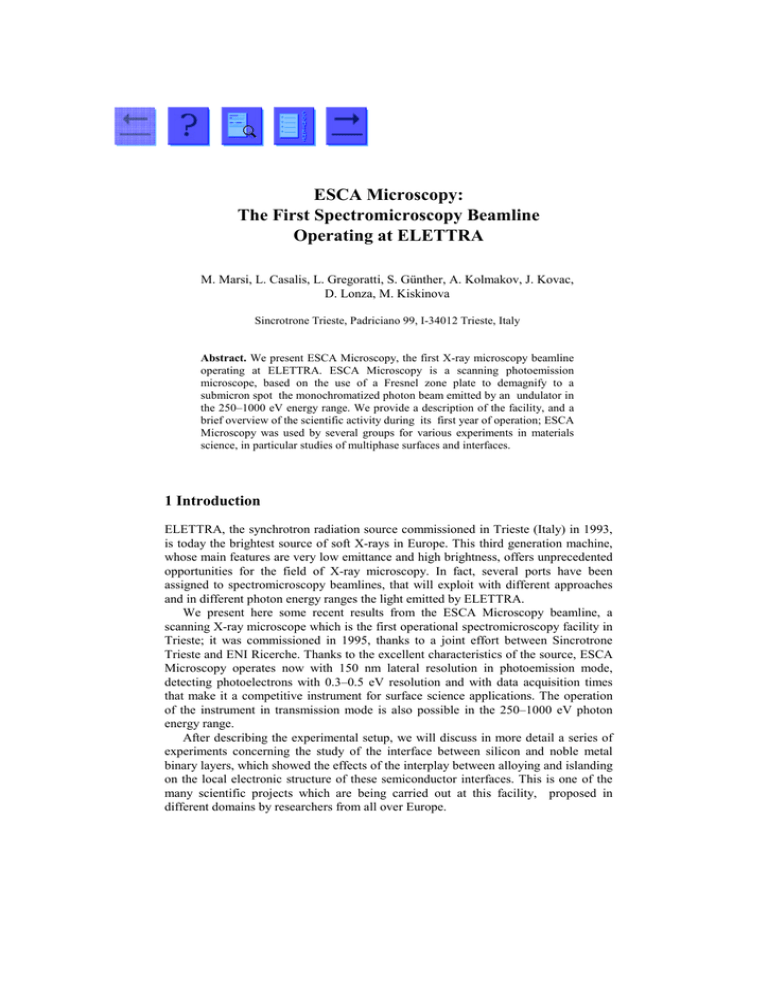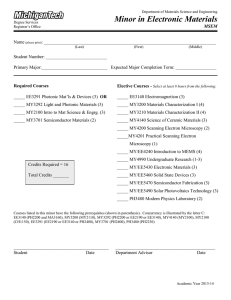ESCA Microscopy: The First Spectromicroscopy Beamline Operating at ELETTRA
advertisement

ESCA Microscopy: The First Spectromicroscopy Beamline Operating at ELETTRA M. Marsi, L. Casalis, L. Gregoratti, S. Günther, A. Kolmakov, J. Kovac, D. Lonza, M. Kiskinova Sincrotrone Trieste, Padriciano 99, I-34012 Trieste, Italy Abstract. We present ESCA Microscopy, the first X-ray microscopy beamline operating at ELETTRA. ESCA Microscopy is a scanning photoemission microscope, based on the use of a Fresnel zone plate to demagnify to a submicron spot the monochromatized photon beam emitted by an undulator in the 250–1000 eV energy range. We provide a description of the facility, and a brief overview of the scientific activity during its first year of operation; ESCA Microscopy was used by several groups for various experiments in materials science, in particular studies of multiphase surfaces and interfaces. 1 Introduction ELETTRA, the synchrotron radiation source commissioned in Trieste (Italy) in 1993, is today the brightest source of soft X-rays in Europe. This third generation machine, whose main features are very low emittance and high brightness, offers unprecedented opportunities for the field of X-ray microscopy. In fact, several ports have been assigned to spectromicroscopy beamlines, that will exploit with different approaches and in different photon energy ranges the light emitted by ELETTRA. We present here some recent results from the ESCA Microscopy beamline, a scanning X-ray microscope which is the first operational spectromicroscopy facility in Trieste; it was commissioned in 1995, thanks to a joint effort between Sincrotrone Trieste and ENI Ricerche. Thanks to the excellent characteristics of the source, ESCA Microscopy operates now with 150 nm lateral resolution in photoemission mode, detecting photoelectrons with 0.3–0.5 eV resolution and with data acquisition times that make it a competitive instrument for surface science applications. The operation of the instrument in transmission mode is also possible in the 250–1000 eV photon energy range. After describing the experimental setup, we will discuss in more detail a series of experiments concerning the study of the interface between silicon and noble metal binary layers, which showed the effects of the interplay between alloying and islanding on the local electronic structure of these semiconductor interfaces. This is one of the many scientific projects which are being carried out at this facility, proposed in different domains by researchers from all over Europe. III - 100 M. Marsi et al. 2 Experimental Setup ESCA Microscopy is a scanning photoemission microscope, based on the use of Fresnel zone plates to demagnify the X-ray beam [1,3]; similarly to other scanning instruments [4], it has the advantage of decoupling in this way the energy resolution of the photoelectrons from the lateral resolution, obtained only with the photon beam. The main components of the instrument, that we will briefly describe in the next paragraphs, are: the undulator, a spherical grating monochromator, the zone plate, a sample scanning stage and a photoelectron multichannel analyser. ESCA Microscopy is installed on an undulator port on the 2 GeV ELETTRA storage ring. The X-rays are generated by the U5.6 undulator, a 4.5 m long insertion device with 81 periods (5.6 cm per period), that produces coherent light in the 100– 1500 eV photon energy range [5]. The photons are then dispersed by a high troughput spherical grating monochromator, providing monochromatic photons in the 200-1000 eV range; the measured resolving power of the monochromator is above 3000 in normal operation conditions at the Ar L2,3 edge (244 eV) [6]. The heart of the instrument is the focusing optical system, consisting of a Fresnel zone plate (ZP) and of a pinhole which acts as an order selecting aperture (OSA) to cut the unwanted diffraction orders. The ZP's have been provided by the IESS-CNR (Rome) [7]; the ones we used until now have a 100 nm outermost zone, which allowed us to obtain 150 nm resolution in photoemission mode. Both optical elements can be moved along the three axes by means of inchworm motors, in order to make their precise alignement possible. The microspot is focused on the sample, which is mounted on a scanning stage where both mechnical stepper motors and piezoelectric positioners are used to obtain, respectively, coarse (> 1 µm) and fine (down to 5 nm) movements. This makes it possible to select specific areas of the sample to be studied with the focused photon beam, and to obtain two dimensional photoemission maps by scanning the specimen in the xy plane, such as those shown in Fig.1. Fig. 1. Chemical maps of Au/Ag/Si(111) obtained by scanning the sample with the electron analyser tuned to energies corresponding to the Ag 3d (left) and Au4f core level (right). ESCA Microscopy: The First Spectromicroscopy Beamline III - 101 A multichannel detection hemispherical analyser with 30º acceptance angle collects the photoelectrons from the sample, which makes it possible to detect photoemission spectra from the microspot and to obtain chemical maps when scanning the specimen. A photodiode placed behind the scanning stage to collect transmitted photons, so that switching between photoemission and transmission mode is very easy (the two detection modes can be actually performed simultaneously). A sample preparation chamber, equipped with basic surface science tools such as LEED, AES and an ion sputtering system, is UHV connected to the microscope vessel. This enables sample preparation and basic characterization before its transfer to the microscope chamber. During normal experimental conditions, a flux of 109-1010 photons/second is conveyed onto the focus spot, the photoemission yield of core levels such as Si2p on Si(111)7x7 is of the order of 1-10 KHz with 0.3-05 eV resolution, and the acquisition time of chemical maps such as those in Fig. 1 (64x64 pixels) is about 5-10 minutes. For experiments in domains like surface science, where the relatively short lifetime of the sample under study is a problem, having reached these acquisition times means that photoemission microscopy is no longer only an interesting novelty of great potential, but an efficient and competitive technique. 3 Research Activity What are the scientific challenges for ESCA Microscopy? During its first year of operation, they were mainly directed at providing new information on old problems in surface science. In particular, the full power of photoemission spectroscopy was used to help understand systems that, although studied for a long time, were not well known at the submicron level. For instance, the study of noble metals deposited on graphite required the submicron spatial resolution to study the electronic structure of large individual clusters [8]. Processes that are of fundamental importance in technology, such as oxidation, are very sensitive to the microscopic structure of the materials: a series of experiments are being performed at ESCA Microscopy to understand the effects of grain boundaries in the oxidation of metals (Pb, Sn) [9]. A problem of technological relevance, as well as fundamental interest, is also understanding the interaction between active phase and oxide support for supported catalysts; photoemission spectroscopy can provide very useful information to ascertain whether the support is chemically modified and how the preparation procedure determines the final chemical composition of the active phase, but due to the fact that supported catalysts are particles with size up to hundreds of nanometers, it must be performed with submicron lateral resolution. Measurements are currently under way to understand the chemical interaction between the MoO3 supported catalysts and typical supports such as TiO2 or Al2O3 [10]. In general, ESCA Microscopy is a very valuable research tool when many chemical species and more than one phase are simultaneously present at a surface. The interface between Si and binary metal layers (Ag and Au) is a prototype system in that respect. Although many different techniques were used to study these systems, only photoemission microscopy made it possible to unambiguously identify the electronic III - 102 M. Marsi et al. structure of the different phases present on the surface, thanks to the capability of performing ESCA on microspots. We studied two mirror systems, Ag/Au/Si(111) and Au/Ag/Si(111) [11]. In both cases, after deposition of few layers of the first metal an annealing procedure produced an interface with two distinct phases, with different structure and electronic properties: one is the simple √3x√3–R30o structure, where a single ordered layer of metal atoms covers almost the entire surface, with the exception of submicron sized metal agglomerates that form the second phase. This interface represents a biphase substrate for the deposition of the other metal, that shows a markedly different behavior on the two phases and that was studied extensively in function of coverage and subsequent annealing temperature: in Fig. 1, the Ag metal agglomerates on a Au/Ag/Si(111) surface are clearly visible as white areas in the left image. To demonstrate what information we can get with ESCA Microscopy, Fig. 2 shows the photoelectron spectra taken after Au was deposited on the metallic Ag islands (a), and on the √3Ag-Si flat portion of the surface (b). If in the images one can appreciate the spatial resolution of the instrument, in these spectra we can see how the electron energy resolution (0.4 eV in this case) makes it possible to identify shifted components in the core level photoemission yield, which are related to the different chemical status of the various atomic species present in a portion of the surface of submicron dimensions. Fig. 2. Photoelectron energy distribution curves from two different microspots of a Au/Ag/Si(111) interface. The top spectra (a) were taken on a Ag island, (b) on the flat √3 area. On the metallic islands the Ag3d core level shows a metallic component, where as on the √3 area Ag is present in a chemical state that indicates a bonding formed with Si. The Au4f level, instead, shows again the presence of AuSi reacted species on the ESCA Microscopy: The First Spectromicroscopy Beamline III - 103 √3 flat area, and two components (the same reacted one, plus a metallic one), indicative of a mixed chemical species, on the Ag islands. We would like to stress that the chemical shift between the two Au components is only 0.9 eV, and that they are very clearly resolved in our microspot spectra. Spectra like these ones, obtained for different Au coverages, allowed us to understand that the Au deposited on the √3-Ag phase produces a new √3 reconstruction, while it creates an alloy with Ag and a strong bonding with a preexisting Si skin on the islands [11]. These examples clearly show the actual capabilities of ESCA Microscopy; it is natural to foresee that in the future there will be applications also in the study of surfaces where patterns on the submicron scale have been intentionally fabricated, i.e. ESCA Microscopy will be not only a novel technique to provide new information on old problems, but really a much needed new eye to look at the electronic properties of artificial nanostructures. Acknowledgements ESCA Microscopy is the result of an intense collaborative effort involving many groups. We would like to thank in particular S. Contarini, L. DeAngelis, C. Gariazzo, P. Nataletti, N. Minnaja and G. Perego from ENI Ricerche; M. Gentili, M. Baciocchi and P. DeGasperis from IESS (CNR-Rome); and our collegues from Sincrotrone Trieste, namely P. Melpignano, D. Morris, R. Rosei, A. Savoia, G. Margaritondo, A. Abrami, F. DeBona, A. Gambitta, C. Fava, W. Jark, G. Loda, F. Mazzolini, R. Krempaska, R. Pugliese, F. Radovcic, G. Sandrin and F.-Q. Wei. Special thanks are due to G. Morrison for many illuminating discussions and for his contribution during the commissioning of the microscope. References 1 G. Schmahl and D. Rudolph, Optik 29, 577 (1969); B. Niemann et al., in X-ray microscopy IV, eds. V.V. Aristov and A.I. Erko, 66-75 (1994); J. Thieme et al., ibidem, 487-493. 2 H. Ade, J. Kirz, S.L. Hulbert, S.L. Johnson, E. Anderson and D. Kern, Appl. Phys. Lett. 56, 1841-1843 (1990); J. Kirz, C. Jacobsen and M. Howells, Q. Rev. Biophys. 28, 33-130 (1995). 3 W. Meyer-Ilse et al., these proceedings. 4 J. Voss et al., in X-ray microscopy IV, eds. V.V. Aristov and A.I. Erko, 103-120 (1994); F. Cerrina et al., Appl. Phys. Lett. 63, 63 (1993); U. Johansson, R. Nyholm, C. Törnevik and A. Flodström, Rev. Sci. Instrum. 66, 1398 (1995). 5 L. Casalis et al., Rev. Sci. Instrum. 66, 4870 (1995); B. Diviacco, R. Bracco, C. Poloni, R.T. Walker and D. Zangrando, Rev. Sci. Instrum. 63, 1368 (1992). 6 W. Jark and P. Melpignano, Nucl. Instrum. Methods A349, 263 (1994). 7 M. Baciocchi, R. Maggiora and M. Gentili, Microelectronics Eng. 23, 101 (1994). 8 Bifone, L. Casalis, et al., to be published 9 A.W. Potts, G. Morrison et al., to be published. 10 S. Günther et al. to be published. 11 Kolmakov et al., submitted to Phys. Rev. B; S. Günther et al., accepted by Surf. Sci.





